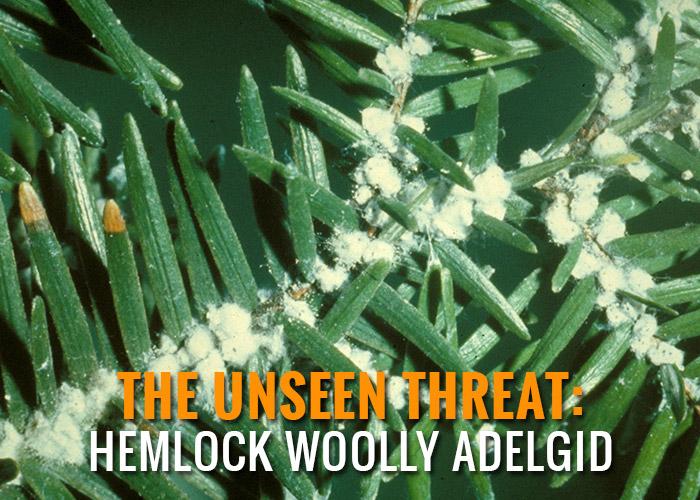The Hemlock Woolly Adelgid (HWA) is a tiny, piercing and sucking insect, unseen with the naked eye that feeds on hemlock twigs at the bases of the needles. HWA is an invasive species from Asia which has infested the US East Coast hemlock forest from New Hampshire to Georgia, inhibiting twig growth throughout. It has also recently been found in Michigan and it is believed to be expanding its range due to changes in climate. HWA has a complex life cycle; its winter generation and spring generation overlap in the spring. It feeds and reproduces during the colder months and then goes dormant in the summer.
Symptoms
The earliest visible sign of HWA are white, cottony masses that are usually located on the twigs and at the bases of the needles. Populations tend to be denser in the lower limbs, but can be anywhere on the tree. Symptoms will progress to fading, thinning and dying limbs, which die off beginning at the base of the tree and moving upwards. Left untreated, the death of the tree is certain.
Treatment Recommendations
1. Arborjet recommends a trunk injection of IMA-jet insecticide using the TREE I.V. system or using the QUIK-jet micro-injector. The TREE I.V. is designed to work effectively with the hemlock’s primitive tracheid vascular system; it injects high volumes of product under low pressure, resulting in efficient uptake. Applications of IMA-jet may be applied in hemlock from September through December, as long as soil temperatures are above 40 degrees F. The second window for application is from March through June. Systemic activity of IMA-jet occurs when the active ingredient, Imidacloprid moves upward into the foliage from the injection sites. The QUIK-jet works best with low volumes of applications in hemlock, and takes only minutes to apply.
2. To give the tree a greater health benefit, a follow up application of ROOT-jet Iron or MIN-jet Iron is recommended, the specific formulation dependent upon soil type. Each product is formulated to supply essential nutrients to support foliar development without added nitrogen, which could exacerbate HWA infestations. When applied to the soil, ROOT-jet Iron supplies phosphorous and potassium, as well as iron and manganese. MIN-jet iron supplies both iron and manganese, micro-elements that may be sequestered in high pH soils, but are essential to healthy, green foliage.
3. The environmental conditions that favor uptake are adequate soil moisture and relatively high humidity. Hot weather or dry soil conditions will result in a reduced rate of uptake, so trees should be watered if applications are made when soil is extremely dry. If treating trees in the summer, inject in the morning for the quickest uptake. The addition of a soil surfactant, such as NutriRoot, as a drench or sub-surface soil injection will encourage water to move deeper into the soil and increase moisture availability to the tree over time. Tree health will also affect treatment efficacy, so assess tree health prior to treating. For example, a declining tree (>50% canopy dieback) is a poor candidate for treatment. In hemlock, fall treatments coincide with HWA resumption of feeding.
After Treatment
Adelgid mortality occurs after ingestion, generally within 14-28 days, and continues for up to 2 years. Cottony masses remain for some time, but will turn a distinctive gray color. Hemlocks respond positively to treatment with a resumption of twig growth.
Do you have questions about HWA or Arborjet formulas? Contact us!

